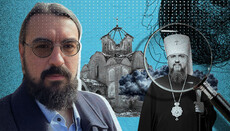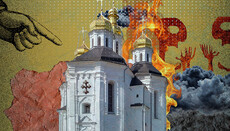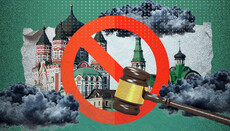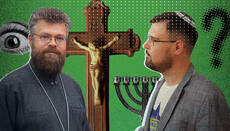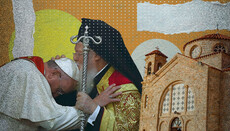About the сross sign and the non-cross gesture
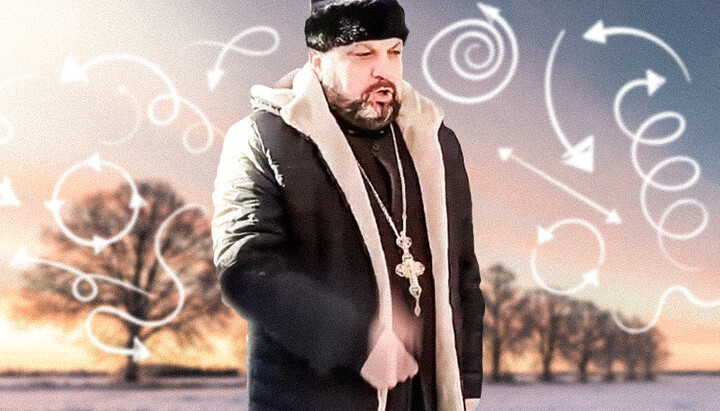
The Cross is a weapon against the devil. But what if a person distorts it and turns it into a mockery? This is also a confession – but the confession of what?
Seizures of temples using violence, with inhumane treatment of believers – this is sacrilege against the temples. But that's not all. Invaders go further and commit blasphemous actions against the main symbol of Christianity – the Honorable and Life-Giving Cross.
The screen below shows the movement pattern of the "sign of the cross" by the "archpriest" of the OCU Mykhailo Torbakhevych, who participated in the seizure of the Kazan church of the UOC in Ladyzhyn.
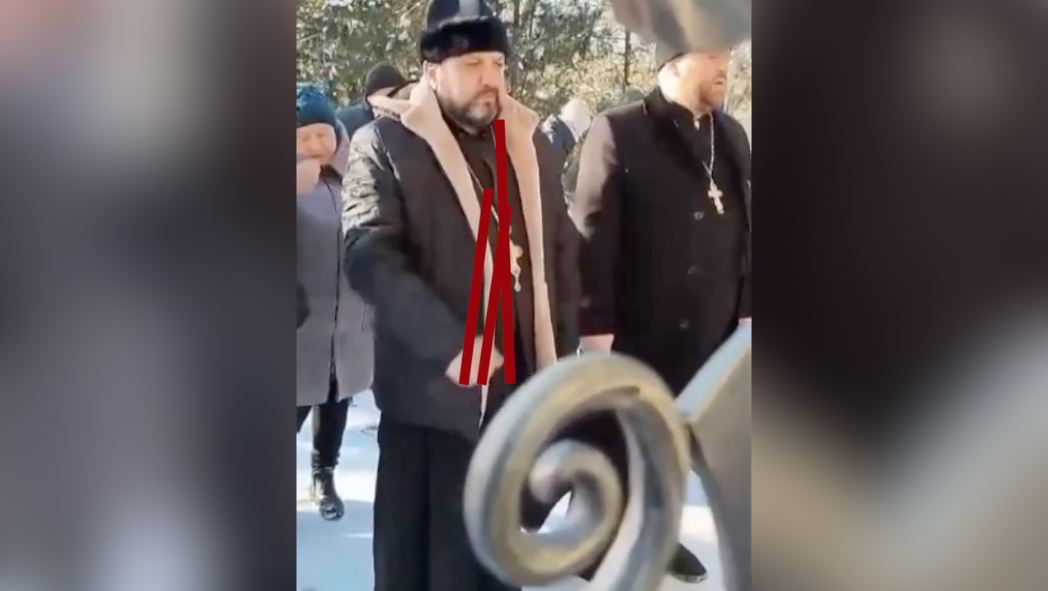
We are used to the fact that some representatives of the OCU (and not only) carelessly make the sign of the cross on themselves. But let's remember how it should actually look. The UOJ compared the Orthodox cross with what Torbakhevych depicts on himself. The difference is impressive.
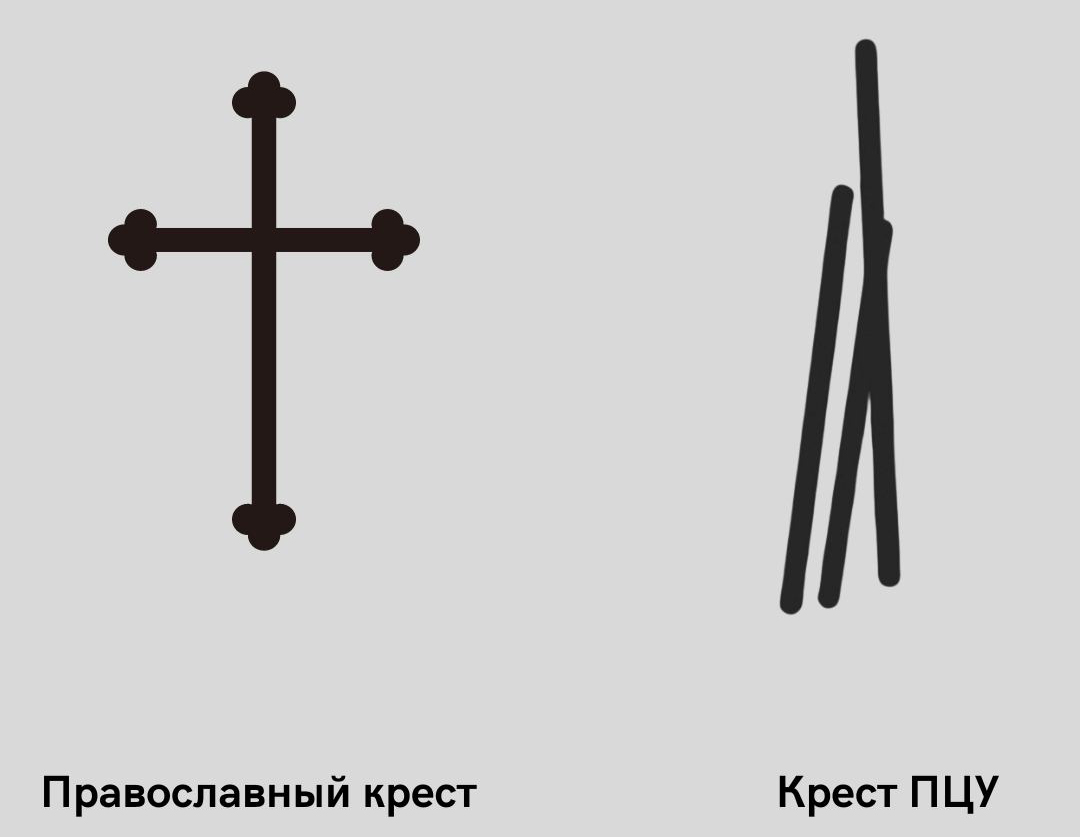
And here's another frame featuring MP Mykola Kniazhytsky from the party of the former president P. Poroshenko "European Solidarity", who enters the seized church in Lviv.
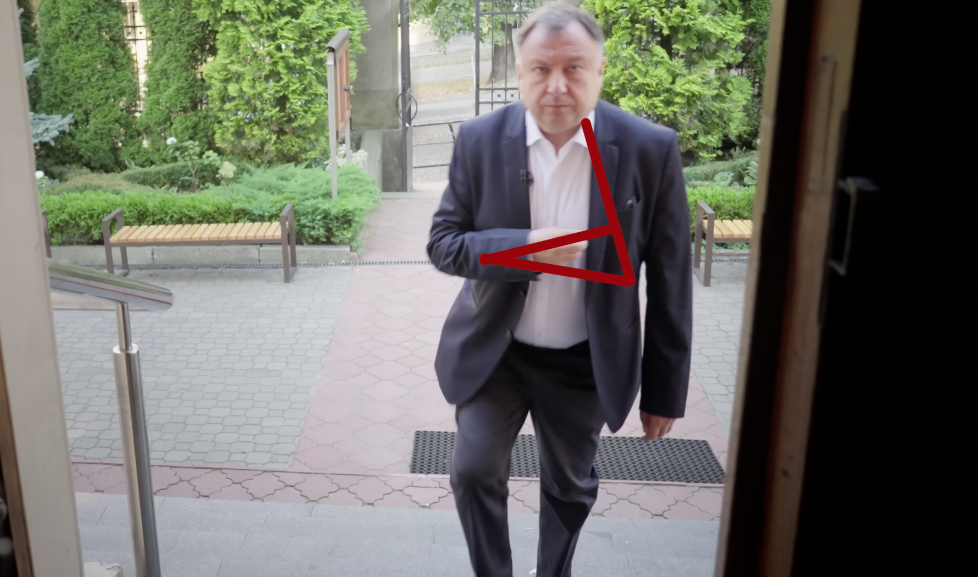
Instead of making the sign of the cross, he draws some kind of triangle on his belly. Moreover, in the Catholic manner, from left to right. M. Kniazhytsky is one of the most active propagandists of the Tomos of the OCU and a hater of the UOC. In 2022, he submitted to the Verkhovna Rada for consideration the most odious bill on the prohibition of the UOC, where he wrote that only those who are part of the structure of Serhiy Dumenko can call themselves Orthodox in Ukraine. You might think that the triangle happened by accident, the hand hurt, or something else. But other frames only confirm that the MP, considering himself a specialist in religious matters, depicts exactly the same sign on himself. Here is a still from a church in the Carpathians.
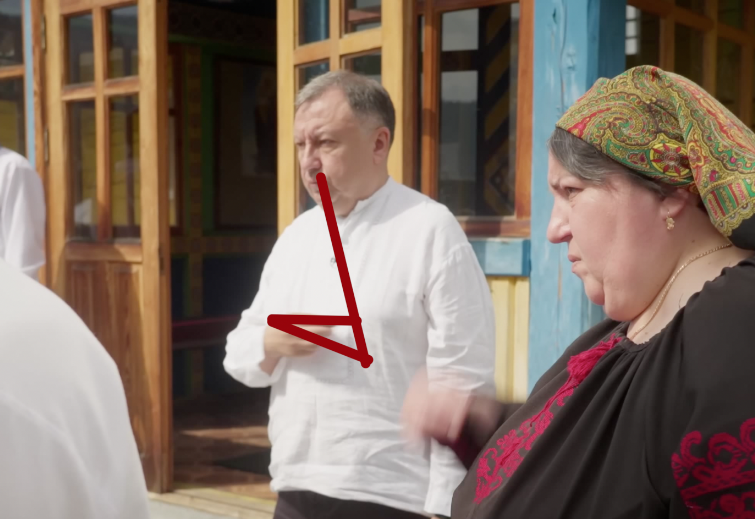
And here Kniazhytsky draws some zigzag instead of the sign of the cross, but already – from right to left.
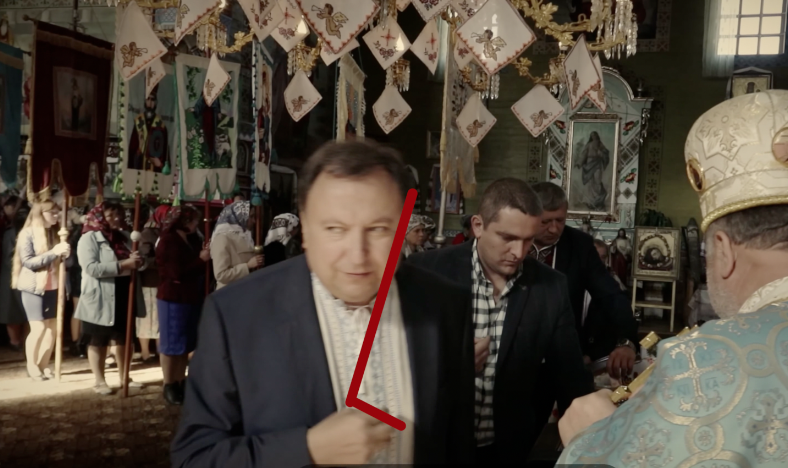
Moreover, all these frames are not espionage shots by the UOJ. These screenshots are from a documentary by Kniazhytsky called "Church Without Christ" (which he "dedicated" to the UOC). In other words, Kniazhytsky himself released it to the public. Therefore, he is confident that there are no problems with his "sign of the cross".
It should be said that the cases with Kniazhytsky and Torbakhevych accidentally surfaced in the "media" field. In reality, there are many of them. A number of church raiders use non-cross gestures to bless themselves.
How exactly one should make the sign of the cross on oneself is indicated in the book "Psalter", which the holy fathers recommend Christians to read daily: "As to how the Orthodox Christian, according to the ancient tradition of the holy Apostles and the Holy Fathers <...> should depict the sign of the cross on themselves <...> Here it is: the first on our forehead, and the upper horn of the cross touches it, the second on our stomach (abdomen – Ed.), and its lower horn reaches it, the third on our right shoulder, and the fourth on the left, and the cross's transverse extensions are signified by the ends of the cross, on which the crucified for us the Lord our Jesus Christ is stretching out his hands, gathering all gentiles scattered at all of the ends into one."
And in the book "Law of God", it is visually shown how to make the sign of the cross on oneself. The authors of the book strictly warn against incorrectly depicting the Cross of the Lord, because it is only to the joy of the demons.
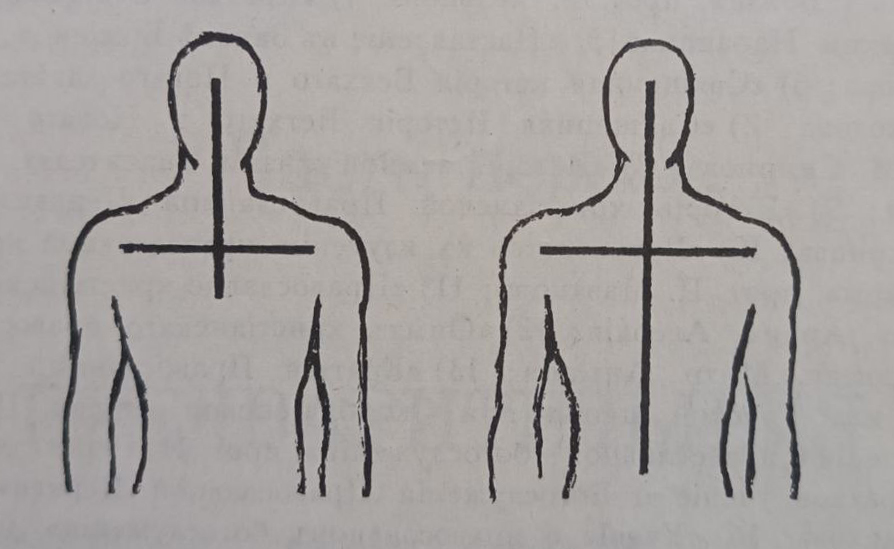
Let's think about what the sign of the cross really means for a Christian?
"Lord, Your Cross has been given to us as a weapon against the devil. For he trembles and shakes, unable to endure looking at its power, as it raises the dead, abolishing death. Therefore, we worship Your burial and resurrection" (from the praises of Sunday stichera, tone 8).
The Cross is a weapon against the devil, against whom he can not only do nothing but cannot even look. This is the teaching of the Church, expressed by many holy fathers, but we will limit ourselves to the works of St. John Chrysostom, not to overload the article. This saint speaks of where a Christian should depict the sign of the cross: "With great zeal, we trace the cross on our dwelling, on the walls, on the windows, on the forehead, and in the mind. This sign is our salvation, universal freedom, and the mercy of the Lord."
Note that Chrysostom says that the Cross should be depicted not only on the forehead, i.e., on our body but also in the mind. Blessing oneself with the sign of the cross, a Christian raises his mind to Golgotha, to the Crucified Savior, to that great Sacrifice by which we are redeemed from sin and death. In another place in the works of John Chrysostom, we find an explanation for this: "When you imprint the cross on yourself, mentally represent the entire meaning of the cross, and you will quench anger and all other passions."
But what if a person draws some triangles or completely incomprehensible lines on themselves? What does he elevate his mind to, what does he imagine? St. John teaches that even correctly depicted sign of the cross has no power if a person lacks faith and determination to follow Christ. He writes: "Do not trace the cross just with a finger, but first willingly, with great faith, and only then bless your face with it. No unclean demons will be able to stand near you, seeing that sword with which it was struck, seeing the sword by which it was cut to death."
The description of the sign of the cross as a sword against evil demons is found in many holy fathers and in numerous liturgical texts. Countless cases with holy ascetics and ordinary believers described in Christian literature testify to the power of the sign of the cross.
St. John Chrysostom writes: "The sign of the cross, even among our ancestors, opened locked doors, destroyed deadly poisons, shattered the power of hemlock, and healed the bites of harmful animals. If it opened the gates of hell, shook the vaults of heaven, and renewed the entrance to paradise; if it cut off the devil's snares—what is surprising in the fact that it will overcome deadly poisons, beasts, and everything else? Trace it in your mind, embrace the salvation of our souls. This cross turned the universe, dispelled delusion, revealed the truth, made the earth into heaven, and transformed people into angels. Therefore, the demons are no longer fearsome but deserving of contempt, and death is no longer death but sleep; everything that opposes us is cast down and trampled."
What happens to a person who does not bless himself with the sign of the cross or does it carelessly is also extensively described in spiritual literature. For example, there is a story about St. Isaac of Pechersk, who faced a strong demonic temptation on his ascetic path. Demons appeared to him in the form of beautiful young men and demanded worship. And because Isaac did not bless himself with the sign of the cross, their trick worked perfectly. This is how the "Pechersk Paterik" narrates it:
"Once, when evening came, he began, as usual, to prostrate and sing psalms until midnight. Tired, he extinguished the candle and sat in his place. And behold, suddenly, a bright light shone in the cave, like the sun, unbearable for the eyes, and two demons came to him in the form of beautiful youths; their faces shone like the sun, and they said to him, 'Isaac, we are angels, and here comes Christ with other angels to you.' Rising, Isaac saw a multitude of beings whose faces shone like the sun. One of them shone brighter than all, and rays emanated from his face. They said to the saint, 'Isaac, this is Christ; bow down and worship him.' Isaac, not understanding the demonic action and forgetting to protect himself with the sign of the cross, bowed down to him as if to Christ. The demons then let out a loud cry and shouted, 'You are ours, Isaac.'"
Let's reiterate: this describes the consequences if a person forgets to bless themselves with the sign of the cross. But what if they distort this sign? On this matter, the book "God's Law" tells us the following: "The sign of the cross gives us great strength to repel and overcome evil and perform good, but we must remember that the cross should be made correctly and deliberately; otherwise, it will not be an image of the cross but a mere waving of the hand, which only demons rejoice in. By carelessly making the sign of the cross, we show our disrespect towards God – we sin, and this sin is called blasphemy." Therefore, the "guitar-playing" that we observe in the actions of many invaders of Orthodox churches is considered blasphemy. Holy Scripture expresses an even stronger statement: "Cursed is he who does the work of the Lord with slackness..." (Jeremiah 48:10).
Therefore, those who bless themselves with the sign of the cross carelessly are subjecting themselves to this curse. John Chrysostom says referring to the image of the Cross, "No unclean demons will be able to stand near you, seeing that sword with which it was struck..." Therefore, according to the saint's words, the opposite is also true: unclean demons surround those who do not protect themselves with the sign of the cross, and even more so, those who blaspheme by doing it carelessly.
Another thought from St. John Chrysostom is, "Every time you shield yourself with the sign of the cross, be filled with great boldness and offer yourself entirely as a pleasing sacrifice to God." This means that those who make the sign of the cross correctly elevate their minds to God and present themselves as a sacrifice to Him.
Christ was crucified on the Cross for each of us; He is the "living sacrifice, the Lamb of God who takes away the sins of the world" (9th Ode of the Canon of Holy Saturday). Those who defend their churches with prayer and the sign of the cross resemble Him in this sacrificial feat. But what do those who attack these churches and depict various symbols on themselves resemble? Anything but the Cross of Christ.
